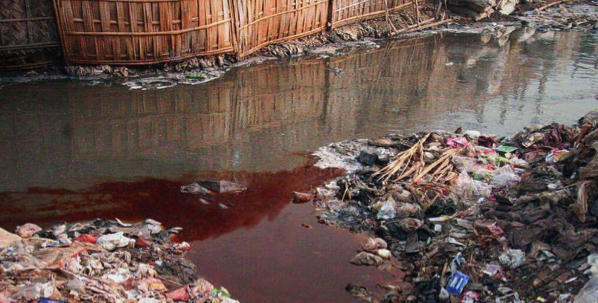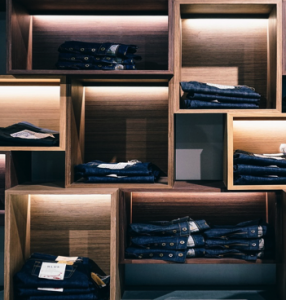
Imagine looking out at your local waterway and being able to distinguish the fashion industry’s color of the season by the hue of the water. In China and other fast fashion producer countries, this is an everyday reality.
Recently I attended a screening of RIVERBLUE, a documentary on the pollution perpetrated by the global textile fashion industry. As the title suggests, the manufacturing of a fashion staple item––bluejeans––and subsequent dumping of toxic chemicals associated with the dying process into waterways has destroyed local aquatic ecosystems.
The connection between western consumer practices and environmental degradation in producer countries is sobering. As consumers, we bear a responsibility to be conscious about our consumption activities, especially in the realm of fast fashion here in the United States.
Fast Fashion In Context
The fashion industry has been in steady boom mode for over two decades. According to the McKinsey State of Fashion 2017 Report, total industry value was projected to reach $2.4 trillion in 2016. If the industry were a country, it would be ranked as the world’s 7th largest economy.
At the same time, apparel companies are facing rising production costs. They are paying more for labor, energy, and raw material while consumers are paying less for clothing each year. Who is paying the price to fill this gap?
The answer is textile workers and the environment. Companies are cutting costs at the production level, and environmental and worker safety measures are noticeably absent from factories. The State of Fashion 2017 Report identifies five fundamental problems for the fashion industry:
- High water consumption
- Discharge of hazardous chemicals
- Violation of human rights and labor standards
- Greenhouse gas emissions
- Waste production
Exposing the Environmental and Human Costs of Fast Fashion

RIVERBLUE documents manufacturing processes at facilities in China, India, and Indonesia that produce the jeans we buy here in the U.S. from major brands. In these factories, workers are exposed to harsh dyeing chemicals without protective clothing. They work long hours in buildings set to maintain nearly 100% humidity (necessary for the dyeing and treatment process).
In the film, documentarian and activist Mark Angelo explains that over 3,000 liters of water are used to make a single pair of jeans and that much of the untreated wastewater flows back into local waterways.
The film makes it apparent that the textile industry pays no regard to human or environmental health and that this is happening across clothing sectors in factories all over the Global South. Yet, major fashion brands demand increased production and consumers keep buying the clothes.
Clothing Recycling: Out of Sight Out of Mind
Americans throw away a ton of clothing each year—the EPA reports that 84% of unwanted clothes in the United States in 2012 went into either a landfill or an incinerator.
How can that be? If you’re like me, the average consumer, you do your best to recycle. You’ll go through periods of needing a wardrobe reset and refresh, perhaps twice a year. You’ll:
- clean out your closet
- decide what stays and what gets tossed
- haul your pile of unwanted clothing to a thrift store or straight to the donation bin
But despite our best efforts to recycle our discarded clothing items, most of them end up in a landfill. The EPA states that “in less than 20 years, the volume of clothing Americans toss each year has doubled from 7 million to 14 million tons, or an astounding 80 pounds per person.”
To compound this issue, due to the manufacturing and dyeing processes that our clothing goes through, it cannot decompose in a landfill. It continues to pollute the ground and air while sitting amongst all of the other trash we throw away daily.
What Consumers Can Do– Beyond the Quick Fix
Marketing is a powerful force. I, for one, am easily influenced by the tactics big fashion brands deploy to lure us into their stores (both online and brick and mortar) to buy things on a regular basis. Brand ambassadors, fashion magazines, “it moment” styles, and sales events all are orchestrated by those companies to bring in revenue.
Awareness is powerful, as well. A combination of personal innerwork (telling yourself that you have enough) and awareness of the impact of the industry can deflect these tactics. I, for one, don’t need to own ten pairs of jeans–especially given that the true cost of the purchase is hidden away in factories and communities across the globe.
We are living in a crucial environmental moment. Our choices as consumers have the power to drive society towards progress. Learning about the life cycle and true cost of the clothing we buy can shift our daily habits.
Make a Personal Impact on Fast Fashion
Ready to take action as an everyday consumer? Start with these tips and go forth consciously!
Think before you buy: ask yourself if you really need that 10th pair of jeans (or dress, coat, t-shirt, scarf . . . you get the point)
Consider borrowing or renting special occasion outfits
Engage on social media: push brands towards transparency by asking where your clothes come from
Host a clothing swap party with a group of friends and coworkers
Choose repair over replacement of your clothing items in need a touch up.
Collectively, we can influence the big fashion brands to start changing their production models and improving environmental and labor standards.
